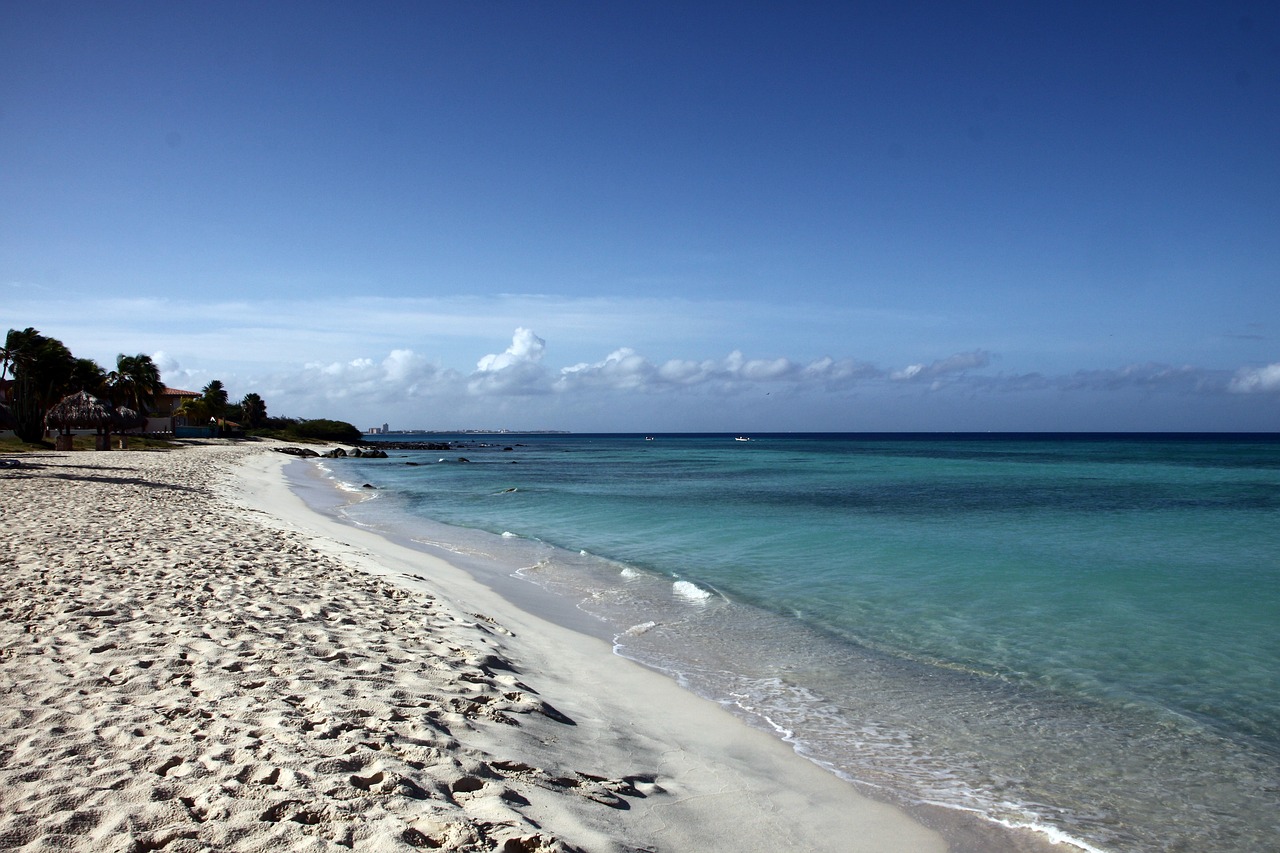Aruba / Land Aruba / Pais Aruba – Let’s explore here
What’s it like in Aruba?
Aruba is an island located in the Caribbean Sea in South America. It is part of the Netherlands, although it’s not part of the EU. Aruba has a population of around 108,000 people (2024), about ¼ of whom live in the capital city, Oranjestad.
The island is roughly 20 miles (32 km) long and 6 miles (10 km) wide, and lies about 18 miles (29 km) from the coast of Venezuela. Aruba is mostly flat with some rolling hills and small limestone cliffs. The highest peak is Jamanota hill, at 617 ft (188 m) above sea level.
Although Aruba relies heavily on tourism like many other Caribbean islands, it is also a tax haven.


A bit about the history of Aruba
Early History and Indigenous People
Aruba was originally inhabited by the Arawak and Caiquetio people, who arrived around 1000 BC. These indigenous groups lived on the island for centuries, developing their own culture, language, and agriculture. When European explorers arrived, the indigenous population had already been living on the island for a long time.
European Discovery and Colonial Period
In 1499, Aruba was discovered by Spanish explorer Alonso de Ojeda. The island became part of Spain’s vast colonial empire in the Americas, although it was largely neglected due to its lack of precious metals and other resources. Over the next few centuries, the Spanish presence on the island remained limited, and Aruba was sometimes under the control of the Dutch during the early 17th century.
Dutch Colonial Rule
In 1636, the Dutch formally took control of Aruba, and the island became part of the Dutch Caribbean colonies. During the 18th century, the Dutch used the island primarily for agriculture and livestock farming, including the cultivation of aloe, which later became an important export. Aruba remained under Dutch rule as part of the Dutch West India Company and later the Dutch Kingdom.
20th Century: Economic Growth and Autonomy
Aruba’s economy saw significant development in the 19th and 20th centuries, particularly with the discovery of oil. In 1924, the Royal Dutch Shell company built an oil refinery on the island, transforming Aruba into a key center of oil production. During World War II, the island’s oil refinery was crucial to the Allies’ war effort. After the war, Aruba became a popular tourist destination.
In 1986, Aruba gained the status of a separate entity within the Kingdom of the Netherlands, known as the ‘Status Aparte’, allowing for greater autonomy. While Aruba remained part of the Kingdom of the Netherlands, it had more control over its internal affairs, including matters related to governance and economic policy.
Modern Aruba
Today, Aruba is a self-governing territory within the Kingdom of the Netherlands, with its own government and legislative assembly. The island has a highly developed tourism industry, with millions of visitors drawn to its beaches and warm climate each year. It is also known for its vibrant cultural heritage, which reflects its diverse history, blending indigenous, African, Dutch, and Latin American influences. It continues to be a prosperous and stable nation in the Caribbean, with a strong economy based on tourism, petroleum, and aloe production.

Aruba road trip
Aruba is our first planned stop on our road trip through the islands of the Caribbean. Our next stop is Curaçao.
Travelling overland between the islands is quite prohibitive due to the lack of transportation options. Travelling between different island countries via ferry is possible, however, ferries only operate between some islands. Chartering private boats between islands is also possible, although travelling with a car in this way is prohibitive. Flying is another option, although again, flights only operate between some islands.
Map of our road trip through Aruba

This is a map of our planned route around the island of Aruba, starting and ending in the Queen Beatrix airport.
Weather in Aruba
When is the best time to visit Aruba?
The best time to visit Aruba is from January to May. During these months, the islands have 8 hours of sunshine per day and rainfall of 0.3 – 1.8 inches (9 – 45mm) per month. The temperature ranges from 25 – 32°C (77 – 90°F).
When is the worst time to visit Aruba?
The worst time to visit Aruba is from July to December. During these months, the islands still have 7-10 hours of sunshine per day. However, humidity rises and it rains an average of 0.8 – 3.3 inches (20 – 85mm) per month. The temperature ranges from 25 – 33°C (78 – 92°F).
Hurricane Season in the Caribbean
Hurricane season in the Caribbean runs from June 1 to November 30. Storms tend to be more frequent and more severe in the latter half of the season.
Hurricanes are least likely during December, January and February.
Travel in and around Aruba
Ferries to and from Aruba
There are no ferries to or from Aruba (2024), despite it being so close to both Curaçao and Venezuela. Flights are available.
What’s it like to drive in Aruba?
They drive on the right hand side of the road in Aruba. In the main, roads are in fairly good condition, with some smaller roads being dirt tracks.
Do you require an international driving permit in Aruba?
We’ve created a dedicated page to driving abroad, which answers this question, and more, which you might find helpful.
Can you use your UK driving license when driving through Aruba?
We’ve created a dedicated page to driving abroad, which answers this question, and more, which you might find helpful.
Do I need a carnet de passages to drive in Aruba?
We’ve created a dedicated page to driving abroad, which answers this question, and more, which you might find helpful.
What are the speed limits in Aruba?
The speed limits for cars in Aruba are:
- 20 mph (30 km/h) for urban driving
- 35 mph (60 km/h) outside of built up areas
- 50 mph (80 km/h) on dual carriageways
- 50 mph (80 km/h) on motorways
What currency do they use in Aruba?
In Aruba they use the Aruban florin, although the US dollar is widely accepted. Cash is widely used. The use of credit / debit cards is widely accepted in tourist areas. Travellers cheques are not generally accepted. There are many ATMs in tourist areas, although not all accept foreign issued cards.
You should make yourself aware of the amount that your bank charges you for using credit and debit cards abroad. Often credit cards are cheaper for purchasing items directly, and for withdrawing cash from ATMs.
What language do they speak in Aruba?
They speak Dutch and Spanish Creole in Aruba. Spanish is also spoken widely. English is spoken in tourist areas.
What time zone is Aruba in?
Remember, when you’re planning your next trip to take a look at what time zone it’s in.
Do I need a visa to visit Aruba?
We’ve created a dedicated, more comprehensive page on visas, which you should find helpful. Check it out!
Is wild camping legal in Aruba?
No, wild camping is illegal in Aruba.
What plug / socket type do they use in Aruba?
In Aruba they use plug / socket types A, B and F.



Health issues in Aruba
Is it safe to drink water in Aruba?
Yes, it is safe to drink tap water in Aruba. Bottled water is also readily available across the country.
What vaccinations are required for Aruba?
This NHS website is kept up to date with all relevant information on vaccinations in Aruba.
Phones in Aruba
What is the country calling code for Aruba?
The country calling code for Aruba is +297
What are the emergency phone numbers in Aruba?
- The emergency number for police in Aruba is: 911
- In Aruba, the emergency number for ambulance is: 911
- The emergency number for fire in Aruba is: 911
If you’ve got some useful info that you’d like to share, let us know!
And don’t forget to check out all the other pictures!
